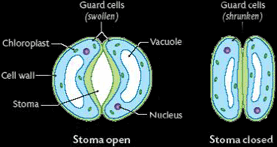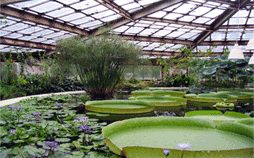Plant Nutrition
Plants are living organisms, they need food in order to keep living. The way they obtain their nutrients however, is completely different than that of ours. Plant make most of their nutrients by them selves, they just need 2 raw materials, these water and carbon dioxide.
The leaf of a plant is considered the kitchen of it. It is where food is made, later on you will see how the leaf is adapted to making food.
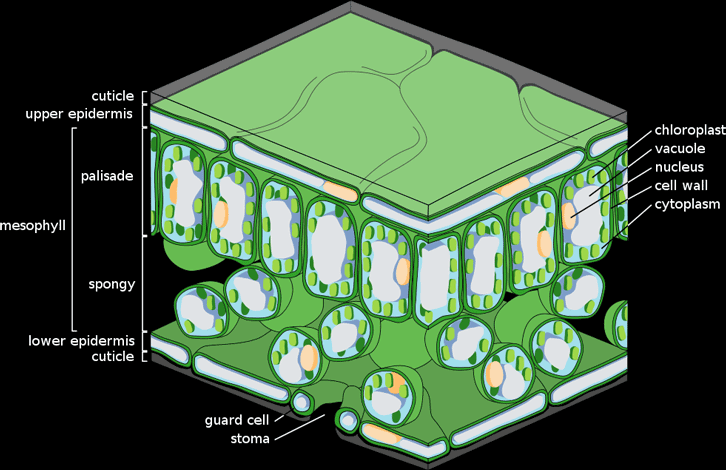
Upper Epidermis: it is a layer of cells that cover the leaf and protect it, it is covered by a layer of wax called cuticle.
Mesophyll Layer:
- Palisade Mesophyll: a layer of palisade cells which carry out most of photosynthesis
- Spongy Mesophyll: a layer of spongy cells beneath the palisade layer, they carry out photosynthesis and store nutrients.
|
Vascular Bundle: it is a group of phloem and xylem vessels that transport water and minerals to and from the leaves. Lower Epidermis: similar to the upper epidermis, only that it contains a special type of cells called guard cells. Guard cells are a specialised type of cells that control the passage of carbon dioxide into the cell and the passage of oxygen out of the cell by opening and closing the stomata (a hole in the leaf through which gases pass) so guard cells are responsible for the gas exchange. |
Photosynthesis:Photosynthesis means “making with light”. It is the process by which plants make useful glucose out of the raw materials water and carbon dioxide, using light energy from the sun. Water is essential for photosynthesis, it is sucked up from the soil by the roots and transported up the stem to leaves where it is put into use. Once carbon dioxide and water are present in the leaf, one condition for photosynthesis is needed, that is light. The two cells in the diagrams are called palisade cells (the rectangular one) and spongy mesophyl cell (the circular one), these are the cells where photosynthesis takeplace. They a structure called chloroplasts, these structures contain a green pigment named chlorophyll, this is to trap sunlight to be used in energy, a large number of chloroplasts is required for photosynthesis. |
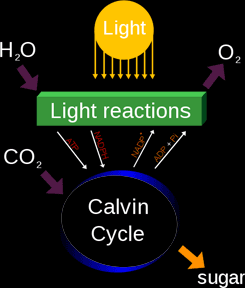 |
How photosynthesis happen:
- Carbon dioxide and water enter the cell
- The cell traps light energy using chloroplasts
- The energy is used to split water (H2O) into hydrogen and oxygen
- The oxygen is excreted outside the leaf to the atmosphere as a waste product
- The hydrogen reacts with carbon dioxide forming glucose.
Overall equation for the Photosynthesis

Carbon Dioxide Supply:
The carbon dioxide moves to the leaf from the atmosphere by diffusion through tiny holes in the leaf called stomata. Carbon dioxide is not present in a high concentration in air, but compared to its concentration inside the leaf, it is more in the air. This is because the cells inside the leaf are always doing photosynthesis (at daytime), converting the carbon dioxide into the glucose quickly, thus the concentration of it inside the leaf decreases, making a concentration gradient for diffusion from the atmosphere to the leaf.
Water Supply:
The water is absorbed by the roots of the plants, then they are transported upwards through a hollow tube called the xylem vessel, till it reaches the leaf where photosynthesis takes place, it enters the leaf through holes in the xylem. Excess water leaves the cell through the stomata, this is called “transpiration”
Sunlight Supply:
The leaves are always exposed to sunlight at daytime. The sun penetrates the transparent layers on the leaf till it reaches the mesophyll layer, where photosynthesis take place. Palisade cells are nearer to the surface of the leaf than the spongy cells, so they receive more of the light and make more photosynthesis.
Factors Needed For Photosynthesis:
- Water
- Carbon Dioxide
- Light
Factors Affecting The Rate Of Photosynthesis:
- Amount of water: the rate increases as it increases
- Concentration of carbon dioxide: the rate increases as it increases
- Light intensity: the rate increases as it increases

Plants at night:
At night, the plant performs several process to convert the stored starch into many useful nutrients like:
- Sugars for respiration
- Cellulose and proteins for making cells
- Vitamins to help in energy action
- Fats as a long term storage material
- Remaining starch is temporarily stored.
Mechanism of Guard Cells:
At daytime, the guard cells open the stomata to allow gaseous exchange, this occurs according to the following steps:
- Sunlight increases the potassium concentration in the vacuoles of the guard cells, the water potential decreases making a gradient between the guard cells and the surround epidermal cells,
- Water moves by osmosis into the guard cells from the epidermal cells,
- The water raises the pressure inside the guard cells,
- The cell wall adjacent to the stomata is thicker and less stretchable then the cell wall on the other side,
- The pressure expand the whole cell except for the inner cell wall (adjacent to the stomata) creating a curve and a pore between the two guard cells,
- The stoma opens.
At night however, the mechanism is opposite:
- Potassium level decreases in the vacuole of the guard cells,
- Water potential increases in the cell and water diffuses out of it,
- The guard cells straighten up because of low pressure closing the stoma.
Mineral Requirements:
The plant is also in need for mineral ions to control chemical activities, grow, and produce materials. The most important minerals are:
- Mg+2 (Magnesium ions): they are important for the production of the green pigment chlorophyll. Lack of it results in lack of photosynthesis and wilting of the leaves,
- Nitrates: these are the sources of nitrogen, they are required to make amino acids and proteins by combining with glucose. Lack of it results in deformation of the plant structure making it small and weak.
Both mineral ions are absorbed from the soil.
Fertilisers:
Sometimes the soil is lacking of the mineral ions needed, this problem can be solved by adding fertilisers to the soil. Fertilisers are chemical compounds rich in the mineral ions needed by the plants. They help the plants grow faster, increase in size and become greener, they simply make them healthier and increase the crop yield. But there are disadvantages of fertilisers, such as:
|
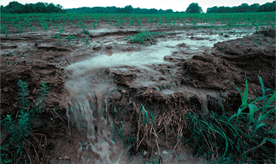 |
Green House:
|
A green house is a placed covered by transparent polythene. In green houses, the limiting factors of photosynthesis are eliminated, and the plants are provided the most suitable conditions for a healthy, rapid growth. The soil in green houses is fertilised and very rich in mineral ions, assuring healthy, large yields. More carbon dioxide is supplied to the crops for faster photosynthesis. The polythene walls and ceiling allow heat waves and light rays only to enter and prevent harmful waves, thus providing a high light intensity and optimum temperature, sometimes a heating system is used too. A watering system is also present. The disadvantages of green houses are that it is too small to give a large yield and that it is expensive. |
